4 Statues in Orange Statues Walking on Each Other Art
If y'all know what to look for, you can tell the meaning of a Buddha Statue by looking at the pose / posture, and the accompanying paw gestures. Each traditional pose has a significance related to an of import issue in the the life - or past lives - of the Historical Buddha. (Note: You tin encounter more examples by Visiting our Buddha Statues For Auction Page on this site.) Also referred to as an asana or an Mental attitude, there are over 100 poses illustrating the life of the Buddha. And each posture will have a specific hand gesture, called a Mudra, associated with the posture. In full general, the carvings of the Buddha that y'all can buy are representations of highly venerated statues that are enshrined at major temples throughout the world, or are reproductions of well known sculptures that were originally commissioned by royal patrons, and every bit such, their meanings and significance are like to the original statues.
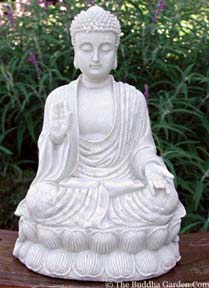 Protection Buddha
Protection Buddha
(Click To View Larger Prototype)
Protection Buddha / Overcoming Fright
This depiction of a seated Buddha with the correct mitt raised and facing outwards has ii mutual meanings. The beginning is that of the Protection Buddha, as the raised right paw symbolically represents a shield. The second meaning, Overcoming Fright, is closely related to the first (since i who is receiving protection would exist less fearful).
The main features of this pose, aside from the raised right hand, is that The Buddha can be depicted either sitting or standing, and the left hand may either be extended outward or palm up in the lap. This statue signifies courage and offers protection from fear, delusion and anger.
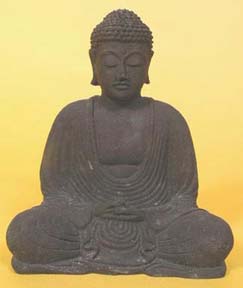 Meditation Buddha
Meditation Buddha
(Click To View Larger Epitome)
Meditation Buddha / Quiet Buddha / Calming Buddha
Another of the more mutual rupas is of the Buddha in Meditation. This statue is for people who are either looking for peace and clam in their lives, or for those who wish to amend their own meditation skills. People volition often purchase a Meditation Buddha if they want to set upwards a "tranquillity room" or a corner of their house where they can sit in calm for a little while and unwind.
In this pose, the Buddha is depicted with both easily in the lap, face up, and the legs are crossed, either in a Double Lotus pose (with the ankles of each leg tucked backside i another in a locked position), or in a Single Lotus pose (where ane leg rests on top of the other leg). Occasionally, an alms basin is placed in the lap as well.
Every bit this statue mostly represents focused concentration, the eyes of the Buddha are either depicted as halfway closed, or closed virtually all the style. The silhouette of the statue is shaped - more than or less - like a triangle, which represents stability.
Many of the largest Buddha Statues in Japan, such as the Not bad Kamakura Buddha Statue at Kotokuin Temple, and large statues in Korea are in the Meditation Pose. This pose is also known as the Amithabha Buddha, which means "Dizzying Calorie-free."
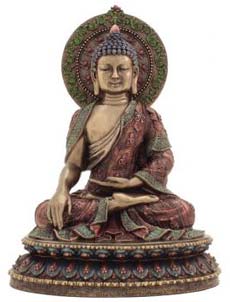 Globe Touching Buddha
Globe Touching Buddha
(Click To View Larger Prototype)
Calling The World To Witness / Earth Touching Buddha
The most common pose you volition notice in Thai temples is with the legs crossed, the left hand in the lap, and the correct hand pointing to the ground with the palm facing inward toward the Buddha. This posture is known as Calling The World to Witness, and information technology is the definition of the moment of enlightenment for the Buddha.
It is the story of how the Buddha, after half-dozen years, finally was at the verge of enlightenment. Unfortunately Mara, the Demon of Illusion, tried to dissuade The Buddha from the final concluding steps. The Buddha meditated all night to overcome the fears and temptations sent by Mara, and and then called the Earth Goddess to witness that the Buddha achieved enlightenment in order to share with the remainder of the world. Witnessing that, the Earth Goddess wrung her hair, releasing flood waters that swept away the Demon Mara and all the temptresses he had released.
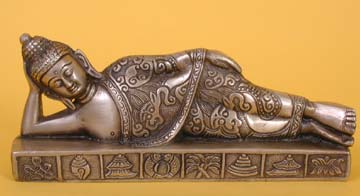 Nirvana Buddha
Nirvana Buddha
(Click To View Larger Image)
The Nirvana Buddha / Reclining Buddha
This statue depicts the Historical Buddha in the final moments of life on earth, prior to the Buddha dying one last time before entering Nirvana (often written in English as ParaNirvana when referring to the life of The Buddha). It is said that an alms giver had accidentally given the Buddha pork that had gone bad, and this eventually led to the decease of the Buddha.
Because the Buddha had gained enlightenment in this lifetime, the Buddha was able to escape the countless bike of birth - death - rebirth (known every bit samsara) and was able to enter Nirvana. In this pose, the Buddha is ever depicted lying on the right mitt side on summit of a resting table. One of the most well-known examples of this statue is enshrined at Wat Pho in Bangkok, Thailand, although at that place are numerous other temples throughout Southeast Asia that firm statues in the posture.
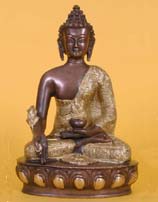 Medicine Buddha
Medicine Buddha
(Click To View Larger Paradigm)
Medicine Buddha
The Medicine Buddha is depicted in paintings having blue skin, simply whether shown in statue or painted course, the right hand is held facing downward with fingers extended toward the ground, palm facing outward toward the viewer, a bowl of herbs rests in the left hand upon the lap.
It is believed by the Tibetans that the Buddha was responsible for delivering the knowledge of medicine to the people of the world, and in fact the right mitt facing outward signifies "granting a boon" (pregnant, giving a blessing) to mankind. This is a common hand gesture amongst both Buddhist and Hindu statues.
The Medicine Buddha is venerated by those seeking health, and is more usually found in the Buddhist temples and communities of Nepal and Tibet.
Source: https://www.thebuddhagarden.com/buddha-poses.html
0 Response to "4 Statues in Orange Statues Walking on Each Other Art"
Post a Comment